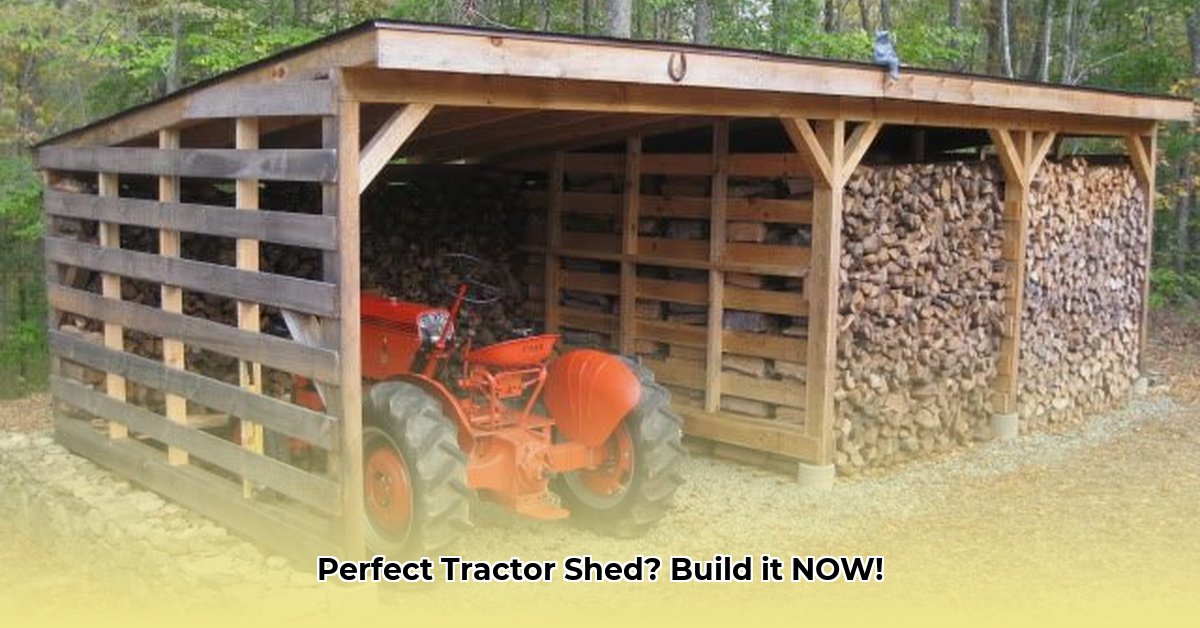
Building a tractor shed is a significant investment, protecting your equipment and extending its lifespan. This guide simplifies the process, covering material selection, design, permitting, construction, and long-term maintenance. Whether you're a seasoned DIY enthusiast or a complete beginner, we'll equip you with the knowledge to build the perfect barn for your needs. For additional resources on water storage solutions, check out this helpful site: water storage options.
Choosing Your Material: Steel vs. Wood
The first major decision involves selecting the right material: steel or wood. Both options offer distinct advantages and disadvantages.
Steel Sheds: Advantages and Disadvantages
Advantages: Steel sheds boast superior durability, resisting harsh weather, pests, and fire more effectively than wood. They require minimal maintenance, often lasting 50 years or more with only occasional touch-ups. This translates to long-term cost savings, despite a typically higher initial investment. The faster construction time also means a quicker project completion.
Disadvantages: The initial cost is higher than wood. Steel can be susceptible to dents and scratches, impacting the aesthetic appeal for some. Professional installation is frequently required, adding to the overall expense.
Wood Sheds: Advantages and Disadvantages
Advantages: Wood sheds typically have lower initial costs, making them an attractive option for budget-conscious builders. Many find the natural aesthetics more appealing, integrating well with various landscapes. They are also easier to customize and can be a rewarding DIY project.
Disadvantages: Wood sheds have significantly shorter lifespans than steel, requiring more frequent maintenance (painting, treating for pests and rot). They are more vulnerable to damage from weather, insects, and fire, leading to higher lifelong expenses.
Cost Comparison: A Long-Term Perspective
While wood sheds often have a lower initial price, remember to factor in the cumulative costs of ongoing maintenance, repainting, pest control, and eventual replacement. Steel sheds' upfront expense is often offset by their significantly longer lifespan and reduced maintenance requirements. A thorough cost analysis should consider initial purchase price, installation, annual maintenance, lifespan, and eventual replacement cost for a complete picture.
Designing Your Tractor Shed: Size, Style, and Climate
Careful planning is essential for creating a functional and efficient shed.
Determining the Right Size
Begin by measuring your tractor's dimensions. Add extra space to accommodate additional equipment, tools, and future purchases. Ensure sufficient space for easy maneuverability within the shed. Adequate ventilation is crucial to prevent moisture buildup, mitigating rust in steel sheds and rot in wooden ones. Isn't it frustrating when you can’t easily access your tools because it's too tightly packed?
Choosing an Appropriate Style
Various styles offer different advantages and aesthetic appeal. Gambrel roofs (with two slopes) provide more headroom, while single-slope roofs are simpler and more cost-effective. A-frame designs offer a distinctive look. Roof style should consider the local climate; steeper roofs handle snowfall better.
Planning and Permits: Understanding Local Regulations
Before construction begins, contact your local planning and zoning department to determine building codes and permit requirements. This step prevents delays and potential fines. The permitting process can take time, so plan ahead. Neglecting this step can be incredibly costly – are you willing to risk delays and fines?
Building Your Shed: Prefabricated vs. Custom
Two primary approaches exist for constructing your tractor shed.
Prefabricated Shed Kits
Prefab kits offer a faster, simpler approach. Select a kit that meets your needs, and follow the provided instructions for assembly. While generally manageable for DIY enthusiasts, professional installation is recommended if you lack experience. The ease and speed of prefabricated kits are appealing, yet do you have the skills to handle unexpected challenges?
Custom-Built Sheds
Custom-built sheds offer greater design flexibility but demand more involvement and expertise. You'll need detailed architectural plans and a skilled contractor. Careful budgeting and establishing a realistic timeline are critical. The flexibility of customization is advantageous, but is your budget and timeline suitable for this approach?
Maintaining Your Tractor Shed: A Long-Term Investment
Regular maintenance extends the lifespan of your shed and avoids costly repairs.
Steel Shed Maintenance
Regular inspections for rust are crucial. Address any rust spots promptly with touch-up paint to prevent corrosion. Annual inspections are recommended and more frequent in harsh climates. A little preventative maintenance can save significant expense in the long run.
Wood Shed Maintenance
Regularly inspect for rot, insect damage, and moisture penetration. Repainting or resealing every few years is essential to protect the wood and prevent decay. Good ventilation helps to maintain a dry environment within the shed. Are you prepared for the regular maintenance required for wood sheds?
Conclusion: Careful Planning for Long-Term Success
Building a tractor shed requires meticulous planning, considering various factors from initial material selection to ongoing maintenance. Careful planning now safeguards against future problems and ensures a long-lasting, functional, and valuable asset for years to come.
Resources
- Example Local Government Website for Building Permits
- Example Supplier of Prefabricated Shed Kits